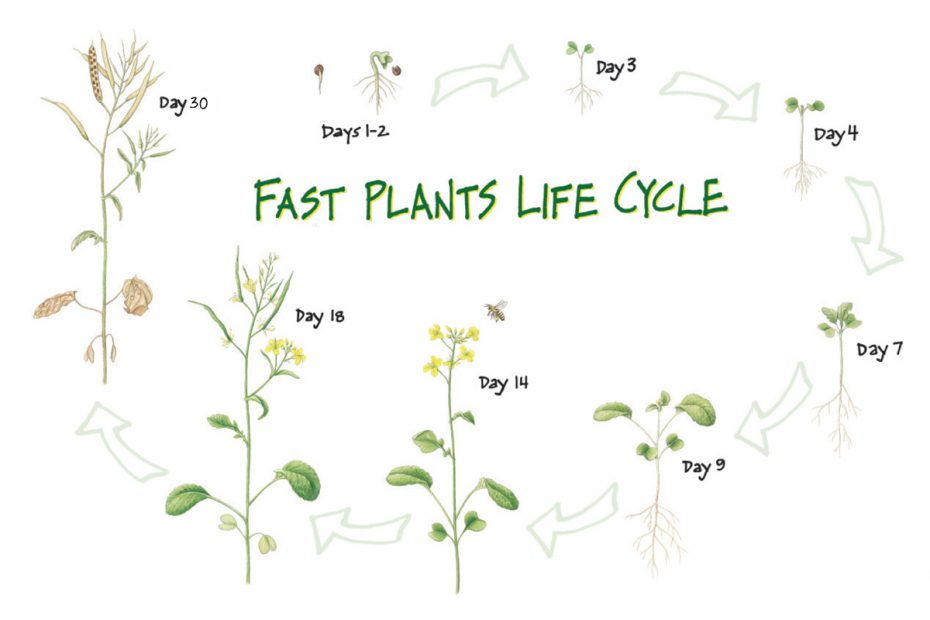Life Cycle Investigations
Life cycle investigations with Wisconsin Fast Plants® provide rich context for teaching and learning a broad range of concepts. Though some think of the plant life cycle as limited to elementary level lessons, investigations and observations made during the Fast Plants life cycle are used worldwide at middle, high school and college levels, too.
Crosscutting Concepts and life cycles
Try to imagine a phenomenon in the life sciences that is more captivating than the amazingly diverse life cycles on Earth. The wonder of how living beings grow through life and the various structures and functions that characterize their life stages never cease to amaze me. And students are equally engaged. Life cycles capture our imaginations and curiosities. They serve as rich context for crosscutting concepts: observing patterns, investigating energy flows and the cycling of matter, for relating structures to functions, and for studying stability and change.
Observing patterns in life cycles on Earth
Life on Earth comprises populations of individuals whose life span varies from a few hours (bacteria) to hundreds or even thousands of years (some trees). Through the cycle of life, repeated from one generation to the next, populations of organisms or species continue on Earth. Life, for many organisms, begins with fertilization. Fertilization marks the time when specialized reproductive cells representing the contributions of a single egg (female) and sperm (male) join to form the zygote (first cell of the new generation).
In more complex organisms the zygote divides repeatedly, progressing through stages of growth and development. It eventually becomes a mature adult, producing reproductive cells that contribute to the next generation. The ways in which various organisms complete their life cycles is extremely varied and a fascinating part of biology.
Kindergarten through college level students who grow Fast Plants from seed to seed, can learn many aspects of biology. Lessons learned can be relevant to understanding themselves as individual organisms. Those same lessons can also lead to understanding other living beings and whole systems on Earth. Students can learn about growth and development, inheritance, and the nature of the dependency among organisms and their environment. Meanwhile, the practices of science can be used and learned by growing and experimenting with Fast Plants.
What can I teach during the different life cycle stages when we grow Fast Plants?
Our newest, Open Source and NGSS-aligned lesson and associated resources for teaching about and with the Fast Plants life cycle is available as a Google document that you may copy & paste into your own Google Drive and edit as you wish. All our Open Source lessons may be freely used and adapted as educational materials that are similarly made available to other educators (share and share-alike).
- Days 0-2: Germination (timelapse video of germinating seeds!) Planting and growing in soil
- Observe seedlings in a Petri dish
- Compare seeds germinated in light and in the dark (energy transformation investigation)
- Days 3-12: Growth and Development
- Measure or count plant parts to collect data
- Analyze individual plant data to draw conclusions about populations
- Days 13-17: Flowering and Pollination (timelapse of blooming flowers!)
- Make your own beesticks(video) and pollinate your plants(video) to produce your own viable seed
- Learn about flower structures and functions
- Ecology of the bee and the brassica
- Days 18-40: Fertilization and Seed Development
- Raise plants to maturity and harvest your seeds(video)
- Discuss the effects of the growing environment on seed yield
- How many seeds can you produce from a single plant?
What kits can I use to teach the Fast Plants life cycle in my classroom?
- Wisconsin Fast Plants Elementary Exploration of Plant Life Cycles Kit
- Reading Green: Investigating the Cycle and Growth of Flowering Plants Kit
- Wisconsin Fast Plants Growth, Development, and Reproduction Advanced Classroom Kit
Additional Life Cycle Resources
You’ll find lots of resources for teaching about life cycles with Fast Plants on our website.
The Seed Challenge lessons include great life-cycle-coordinated lessons. It is free to download as a pdf.
Life in Balance is a set of lessons for exploring the interdependence and inter-connectedness of the Brassica Butterfly and Wisconsin Fast Plants.
Fast Plants Care is a handout that highlights key tending and trouble-shooting tips throughout the life cycle.
And a search for current resources in our digital library, using the key words “life cycle” generates about 50 resources at all different grade levels.
Download from our digital library a jpg of the Wisconsin Fast Plants life cycle that you can print as a poster or handout.
We have great videos on our YouTube channel. Many are relevant to the Fast Plants life cycle.
How do you teach with life cycles?
We’d love to hear how you use the life cycle of Fast Plants in your lessons. If you’ve created resources that you’d like to share, please post a link and description in the comments. Or drop us a note if you’d like to suggest an addition to the Fast Plants digital library.


